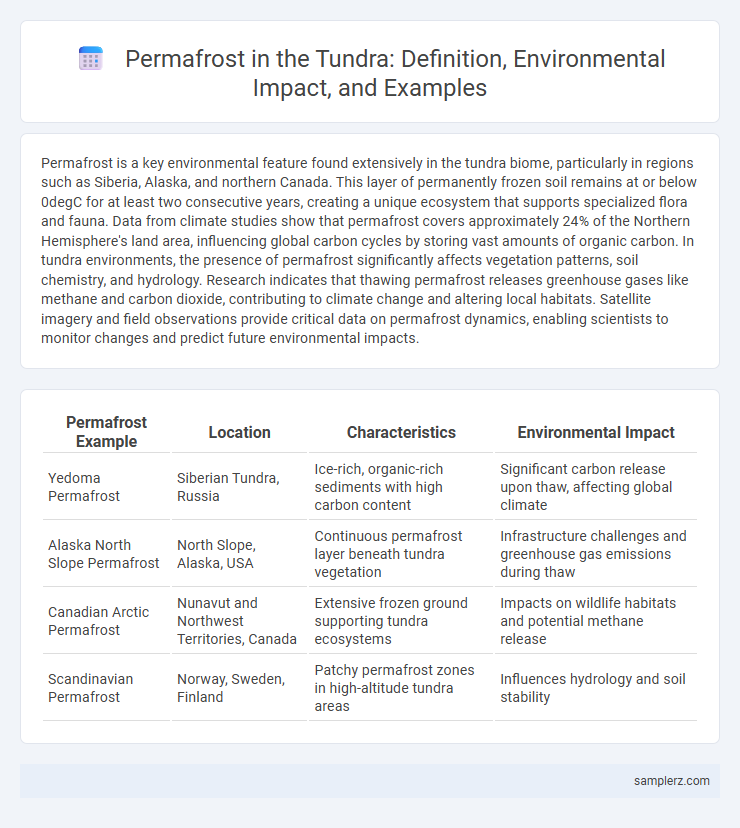Permafrost is a key environmental feature found extensively in the tundra biome, particularly in regions such as Siberia, Alaska, and northern Canada. This layer of permanently frozen soil remains at or below 0degC for at least two consecutive years, creating a unique ecosystem that supports specialized flora and fauna. Data from climate studies show that permafrost covers approximately 24% of the Northern Hemisphere's land area, influencing global carbon cycles by storing vast amounts of organic carbon. In tundra environments, the presence of permafrost significantly affects vegetation patterns, soil chemistry, and hydrology. Research indicates that thawing permafrost releases greenhouse gases like methane and carbon dioxide, contributing to climate change and altering local habitats. Satellite imagery and field observations provide critical data on permafrost dynamics, enabling scientists to monitor changes and predict future environmental impacts.
Table of Comparison
| Permafrost Example | Location | Characteristics | Environmental Impact |
|---|---|---|---|
| Yedoma Permafrost | Siberian Tundra, Russia | Ice-rich, organic-rich sediments with high carbon content | Significant carbon release upon thaw, affecting global climate |
| Alaska North Slope Permafrost | North Slope, Alaska, USA | Continuous permafrost layer beneath tundra vegetation | Infrastructure challenges and greenhouse gas emissions during thaw |
| Canadian Arctic Permafrost | Nunavut and Northwest Territories, Canada | Extensive frozen ground supporting tundra ecosystems | Impacts on wildlife habitats and potential methane release |
| Scandinavian Permafrost | Norway, Sweden, Finland | Patchy permafrost zones in high-altitude tundra areas | Influences hydrology and soil stability |
Introduction to Permafrost in Tundra Ecosystems
Permafrost in tundra ecosystems refers to the permanently frozen ground that remains at or below 0degC for at least two consecutive years, covering nearly 24% of the Northern Hemisphere's land surface. This frozen layer significantly influences soil temperature, hydrology, and vegetation patterns, supporting unique biodiversity adapted to cold environments such as Arctic tundra regions in Alaska, Siberia, and Canada. The continuous and discontinuous permafrost zones within these areas determine the stability of infrastructure and play a crucial role in the global carbon cycle due to trapped organic matter.
Key Characteristics of Tundra Permafrost
Tundra permafrost is characterized by a permanently frozen layer of soil found beneath the surface, often extending hundreds of meters deep. It maintains extremely low temperatures year-round, restricting plant root growth and limiting organic decomposition. This frozen ground plays a crucial role in carbon storage, significantly impacting global climate regulation.
Notable Locations of Permafrost in the Arctic Tundra
The Arctic tundra features extensive permafrost, notably in regions such as Alaska's North Slope, Canada's Yukon Territory, and Siberia's Yamal Peninsula. These areas exhibit continuous permafrost layers that significantly impact local ecosystems and infrastructure stability. Research in these zones provides critical data on climate change effects and permafrost thaw dynamics.
Siberian Permafrost: An Iconic Example
Siberian permafrost, covering approximately 10 million square kilometers, represents one of the largest and most studied continuous permafrost regions globally. This frozen ground stores vast amounts of organic carbon, estimated at nearly 1,600 gigatons, playing a critical role in global climate regulation by trapping greenhouse gases. Rapid warming in Siberia, with temperature increases up to 3degC over the past century, threatens permafrost stability, potentially releasing significant methane and carbon dioxide into the atmosphere.
Alaskan Tundra: Permafrost Features and Distribution
The Alaskan tundra is characterized by extensive permafrost layers, with frozen soil extending up to hundreds of meters deep, significantly influencing the region's hydrology and vegetation patterns. Permafrost in this area is predominantly continuous, except for localized thawed zones known as taliks beneath lakes and rivers. Seasonal thawing of the active layer above the permafrost drives nutrient cycling and supports specialized tundra ecosystems adapted to cold, waterlogged conditions.
Canadian Arctic Permafrost Zones
The Canadian Arctic Permafrost Zones consist of continuous, discontinuous, sporadic, and isolated permafrost, with continuous permafrost covering over 80% of the area. Ground temperatures in these zones remain below freezing for at least two consecutive years, affecting soil stability and ecosystems. These permafrost layers store vast amounts of organic carbon, playing a crucial role in the global climate system.
Scandinavian Tundra Permafrost Examples
Scandinavian tundra permafrost is prominently found in northern Norway, Sweden, and Finland, where mean annual ground temperatures remain below freezing, preserving ice-rich soil layers. These permafrost regions support unique ecosystems and influence hydrological cycles by controlling water flow through frozen soil. Recent studies highlight thawing trends in Scandinavian tundra permafrost due to rising Arctic temperatures, impacting carbon release and local biodiversity.
Impact of Climate Change on Tundra Permafrost
Rising global temperatures have caused accelerated thawing of tundra permafrost, releasing vast amounts of stored carbon dioxide and methane into the atmosphere, intensifying greenhouse gas effects. This thawing disrupts local ecosystems, altering vegetation patterns and threatening native species adapted to frozen conditions. Infrastructure built on permafrost, such as roads and pipelines, faces increased instability and damage due to ground subsidence.
Unique Flora and Fauna Supported by Tundra Permafrost
Tundra permafrost supports unique flora such as mosses, lichens, and dwarf shrubs adapted to cold, nutrient-poor soils. This frozen ground provides habitat stability for specialized fauna like Arctic foxes, caribou, and migratory birds that rely on the tundra's seasonal cycles. The permafrost's persistence influences soil moisture and temperature, creating microhabitats essential for these species' survival in extreme environments.
Conservation Efforts for Tundra Permafrost Regions
Conservation efforts for tundra permafrost regions focus on minimizing thawing through protecting vegetation cover and reducing greenhouse gas emissions that accelerate climate change. Initiatives include restoring native plant species to enhance soil insulation and implementing sustainable land-use practices that prevent soil disturbance. Monitoring permafrost temperature and carbon release with satellite technology supports adaptive management strategies aimed at preserving ecosystem stability.

example of permafrost in tundra Infographic
 samplerz.com
samplerz.com